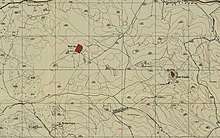Kfar Uria
Kfar Uria (Hebrew: כְּפַר אוּרִיָּה, lit. Uriah Village) is a moshav in central Israel. Located near Beit Shemesh in the Shephelah. It falls under the jurisdiction of Mateh Yehuda Regional Council. In 2018 it had a population of 924.[1]
Kfar Uria | |
|---|---|
Kfar Uria, 2006 | |
 Kfar Uria | |
| Coordinates: 31°47′36.96″N 34°56′54.23″E | |
| Country | Israel |
| District | Jerusalem |
| Council | Mateh Yehuda |
| Affiliation | Moshavim Movement |
| Founded | 1912 (original village) 1944 (first re-establishment) 1949 (second re-establishment) |
| Population (2018)[1] | 924 |
| Wikimedia Commons has media related to Kfar Uria. |
History
The village was first established in 1912 on land bought from Białystok Jews, and served as an agricultural training place. Amongst the residents were A. D. Gordon.
According to a census conducted in 1922 by the British Mandate authorities, Kfar Uria had a population of 40 Jews.[2] This had decreased in 1931 to 10 inhabitants, in 2 houses.[3]
In the 1929 Palestine riots Arab rioters from Jerusalem attacked Kfar Uria, with some local help, robbed and burned down the village. The inhabitants of the adjacent Arab villages for the most part were on good terms with the village's residents and many treated the moshav's association director, Baruch Yakimovsky, as their mukhtar (village chief). He was on amicable terms with mukhtars in surrounding villages. The farmers of the area, both Jews and Arabs, cooperated and defended each other against raiding nomadic Bedouin.
Six Jewish families who had stayed behind were later smuggled out by the mukhtar of Beit Far via one of the ancient natural tunnels that crisscrosses the area. Yakimovsky managed, with the cooperation of some local mukhtars to work Kfar Uria's land for a few more years. In 1944, Jewish stonecutters from Kurdistan rebuilt the village[4] on the ruins of the original site, around 1.5 km north-west Khirbat Ism Allah, but not on village land.[5]


The new village was attacked on 11 January 1948, but repelled by a combination of a Palmach force and an armoured British unit.[6][7] Haganah guards murdered without provocation an Arab peasant couple near the village soon after, in February of that year.[8] A third attempt to settle the area was undertaken in 1949, when a moshav was established on the site. The village name is similar to that of Khirbet Cafarorie, a ruin located south - west of the village, which had a hewn winepress, a mosaic and burial caves.
The village center features an old Khan, which once hosted the agricultural training workers, including A. D. Gordon. The Khan structure remains to this day at the heart of the community, but it requires renovations and therefore closed to visitors.
Between 2009 and 2011 a new neighborhood was built and populated with 69 new houses and families.
In 2013, an archaeological survey was conducted at the site by Irina Zilberbod on behalf of the Israel Antiquities Authority (IAA).[9]
Landmarks
In 1970, Israeli artist Avraham Ofek created a mural for the community center at Kfar Uria. The mural, which covers three walls, each 12.5 meters long and three meters high, tells the story of Israel focusing on the themes of immigration, building the country, and family and Jewish tradition.[10]
See also
- Israeli art
References
- "Population in the Localities 2018" (XLS). Israel Central Bureau of Statistics. 25 August 2019. Retrieved 26 August 2019.
- Mills, 1932, p. 21
- Kark, Ruth; Glass, Joseph B. (2000). "The Jews in Eretz-Israel/Palestine: From Traditional Peripherality to Modern Centrality". In Karsh, Efriam (ed.). Israel: The First Hundred Years. Volume I: Israel's Transition from Community to State. London: Taylor & Francis. p. 101.
- Khalidi, Walid (1992), All That Remains, Washington D.C.: Institute for Palestine Studies, p. 296, ISBN 0-88728-224-5
- Benvenisti, Meron, Maxine Kaufman-Lacusta (translator) (2001), Sacred Landscape: The Buried History of the Holy Land Since 1948, p. 107 ISBN 0-520-23422-7
- Morris, Benny (2008). 1948: A History of the First Arab-Israeli War. New Haven, Connecticut: Yale University Press. p. 102. ISBN 9780300145243.
- Morris, Benny (2008). 1948: A History of the First Arab-Israeli War. New Haven, Connecticut: Yale University Press. p. 80. ISBN 9780300145243.
- Israel Antiquities Authority, Excavators and Excavations Permit for Year 2013, Survey Permit # A-6717
- Ashkenazi, Eli (September 7, 2012). "Wall of Rot: Historic Murals Neglected for Years". Haaretz. Retrieved May 2, 2019.